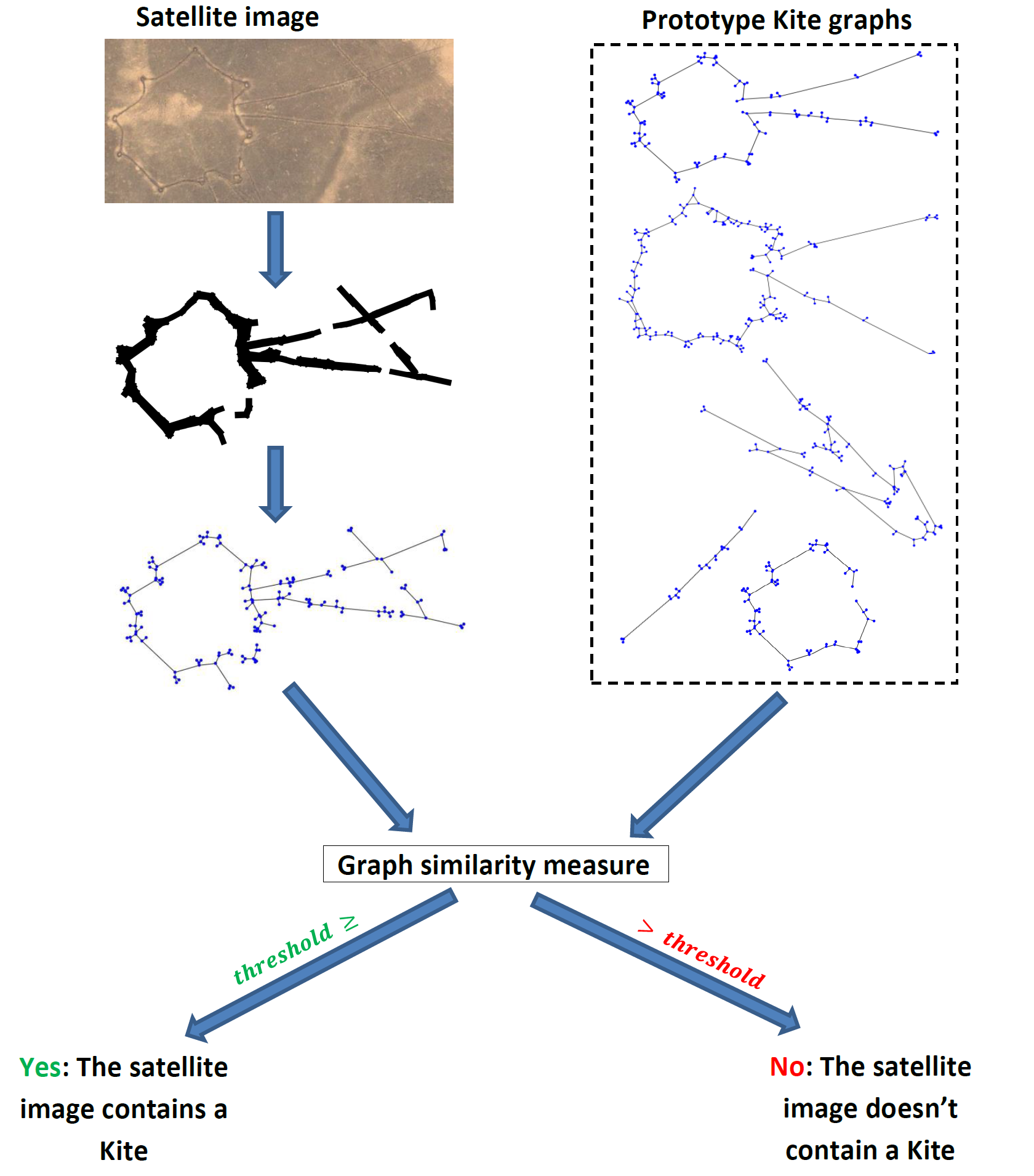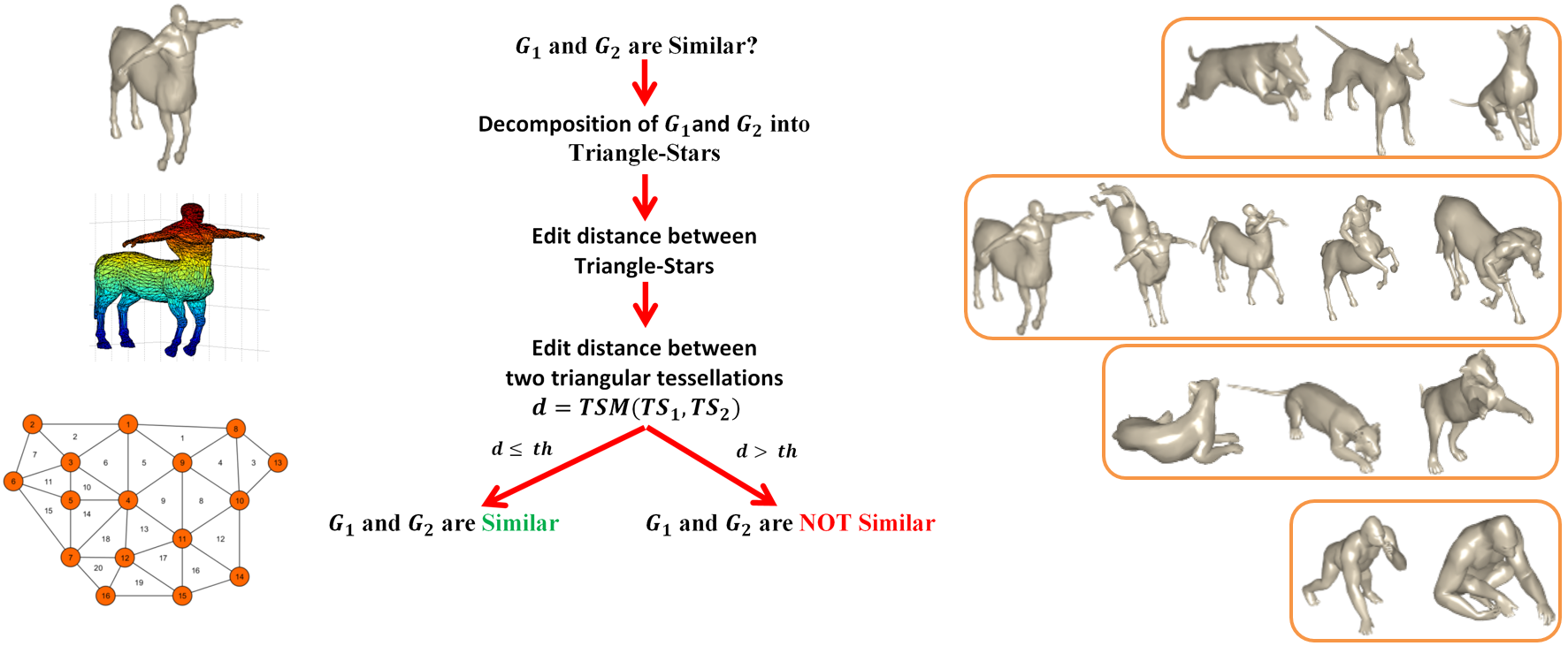Tools and Demos
I have developed several tools using different languages (Java, C/C++, Matlab, etc.) ensuring a complete process for 2D and 3D Pattern Recognition (extraction, representation and classification).
A Graph based approach for Kite recognition
Kamel Madi a, Hamida Seba a, Hamamache Kheddouci a and Olivier Barge b.
a Université de Lyon, CNRS, Université de Lyon 1, LIRIS, UMR5205, Lyon 69622, France.
b CNRS, UMR 5133 Archéorient, Lyon 69365, France.
Kites are huge archaeological structures of stone visible from satellite images. Because of their important number and their wide geographical distribution, automatic recognition of these structures on images is an important step towards understanding these enigmatic remnants. This work presents a complete identification tool relying on a graph representation of the Kites. As Kites are naturally represented by graphs, graph matching methods are thus the main building blocks in the Kite identification process. However, Kite graphs are disconnected geometric graphs for which traditional graph matching methods are useless. To address this issue, we propose a graph similarity measure adapted for Kite graphs. The proposed approach combines graph invariants with a geometric graph edit distance computation leading to an efficient Kite identification process. We analyze the time complexity of the proposed algorithms and conduct extensive experiments both on real and synthetic Kite graph data sets to attest the effectiveness of the approach. We also perform a set of experimentations on other data sets in order to show that the proposed approach is extensible and quite general.

Related publications:
- A Graph based approach for Kite recognition. Kamel Madi, Hamida Seba, Hamamache Kheddouci and Olivier Barge. Pattern Recognition Letters, 2016. [Web Site] [PDF].
- Kite Recognition by Means of Graph Matching. Kamel Madi, Hamida Seba, Hamamache Kheddouci, Charles-Edmont Bichot, Olivier Barge, Christine Chataigner. Graph based Representations in Pattern Recognition (GbR), 2015. [Web Site] [PDF].
- Addressing the Desert Kites Phenomenon and Its Global Range Through a Multi-proxy Approach. Rémy Crassard, Olivier Barge, Charles-Edmond Bichot, Jacques Élie Brochier, Jwana Chahoud, Marie-Laure Chambrade, Christine Chataigner, Kamel Madi, Emmanuelle Régagnon, Hamida Seba and Emmanuelle Vila. Journal of Archaeological Method and Theory. 2014. [Web Site] [PDF].
Graph Edit Distance based on Triangle-Stars Decomposition for Deformable 3D Objects Recognition
Kamel Madi a, Eric Paquet b, Hamida Seba a and Hamamache Kheddouci a.
a University of Lyon, CNRS, University of Lyon 1, LIRIS, UMR5205, Lyon 69622, France.
b National Research Council Canada, Ottawa, Canada.
We consider the problem of comparing deformable 3D objects represented by graphs, i.e., triangular tessellations. We propose a new algorithm to measure the distance between triangular tessellations using a new decomposition of triangular tessellations into triangle-Stars. The proposed algorithm assures a minimum number of disjoint triangle-Stars, offers a better measure by covering a larger neighborhood and uses a set of descriptors which are invariant or at least oblivious under most common deformations. We prove that the proposed distance is a pseudo-metric. We analyse its time complexity and we present a set of experimental results which confirm the high performance and accuracy of our algorithm.
.
Related publications:
- Graph Edit Distance based on Triangle-Stars Decomposition for Deformable 3D Objects Recognition. Kamel Madi, Eric Paquet, Hamida Seba and Hamamache Kheddouci. International Conference on 3D Vision (3DV), 2015. [Web Site] [PDF].